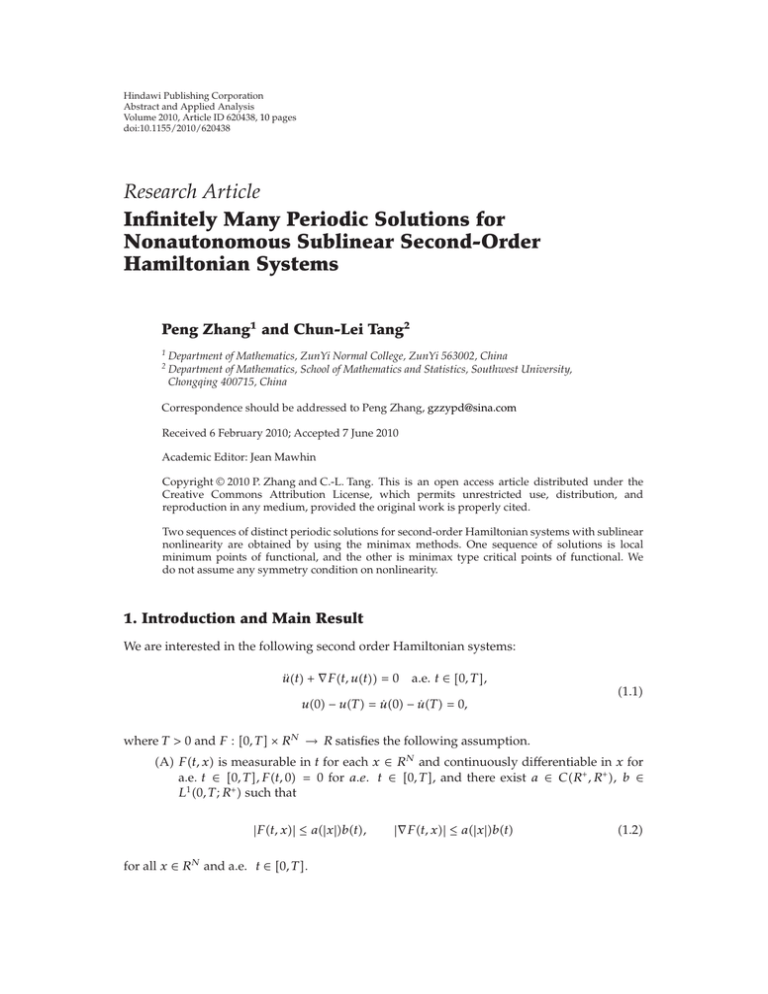Document 10836958
advertisement

Hindawi Publishing Corporation
Abstract and Applied Analysis
Volume 2010, Article ID 620438, 10 pages
doi:10.1155/2010/620438
Research Article
Infinitely Many Periodic Solutions for
Nonautonomous Sublinear Second-Order
Hamiltonian Systems
Peng Zhang1 and Chun-Lei Tang2
1
2
Department of Mathematics, ZunYi Normal College, ZunYi 563002, China
Department of Mathematics, School of Mathematics and Statistics, Southwest University,
Chongqing 400715, China
Correspondence should be addressed to Peng Zhang, gzzypd@sina.com
Received 6 February 2010; Accepted 7 June 2010
Academic Editor: Jean Mawhin
Copyright q 2010 P. Zhang and C.-L. Tang. This is an open access article distributed under the
Creative Commons Attribution License, which permits unrestricted use, distribution, and
reproduction in any medium, provided the original work is properly cited.
Two sequences of distinct periodic solutions for second-order Hamiltonian systems with sublinear
nonlinearity are obtained by using the minimax methods. One sequence of solutions is local
minimum points of functional, and the other is minimax type critical points of functional. We
do not assume any symmetry condition on nonlinearity.
1. Introduction and Main Result
We are interested in the following second order Hamiltonian systems:
üt ∇Ft, ut 0 a.e. t ∈ 0, T ,
u0 − uT u̇0 − u̇T 0,
1.1
where T > 0 and F : 0, T × RN → R satisfies the following assumption.
A Ft, x is measurable in t for each x ∈ RN and continuously differentiable in x for
a.e. t ∈ 0, T , Ft, 0 0 for a.e. t ∈ 0, T , and there exist a ∈ CR , R , b ∈
L1 0, T ; R such that
|Ft, x| ≤ a|x|bt,
for all x ∈ RN and a.e. t ∈ 0, T .
|∇Ft, x| ≤ a|x|bt
1.2
2
Abstract and Applied Analysis
Then the corresponding functional ϕ on HT1 given by
1
ϕu 2
T
2
|u̇t| dt −
T
Ft, utdt
0
1.3
0
is continuously differentiable and weakly lower semicontinuous on HT1 , where
1.4
HT1 u : 0, T −→ RN | u is absolutely continuous, u0 uT , u̇ ∈ L2 0, T ; RN
is a Hilbert space with the norm defined by
u T
2
|ut| dt T
0
1/2
2
|u̇t| dt
1.5
0
for u ∈ HT1 see 1. Moreover,
ϕ u, v T
0
u̇t, v̇tdt −
T
∇Ft, ut, vtdt
1.6
0
for all u, v ∈ HT1 . It is well known that the solutions of problem 1.1 correspond to the critical
points of ϕ.
There are large number of papers that deal with multiplicity results for this problem.
Infinitely many solutions for problem 1.1 are obtained in 2–4, where the symmetry
assumption on the nonlinearity F has played an important role. In recent years, many authors
have paid much attention to weaken the symmetry condition, and some existence results on
periodic and subharmonic solutions have been obtained without the symmetry condition
see 5–7. Particularly, Ma and Zhang 6 got the existence of a sequence of distinct periodic
solutions under some superquadratic and asymptotic quadratic cases. Faraci and Livrea 7
studied the existence of infinitely many periodic solutions under the assumption that Ft, x
is a suitable oscillating behaviour either at infinity or at zero.
In this paper, we suppose that the nonlinearity ∇Ft, x is sublinear, that is, there exist
f, g ∈ L1 0, T ; R and α ∈ 0, 1 such that
|∇Ft, x| ≤ ft|x|α gt
1.7
for all x ∈ RN and a.e. t ∈ 0, T . We establish some multiplicity results for problem 1.1
under different assumptions on the potential F. Roughly speaking, we assume that F has
a suitable oscillating behaviour at infinity. Two sequences of distinct periodic solutions are
obtained by using the minimax methods. One sequence of solutions is local minimum points
of functional, and the other is minimax type critical points of functional. In particular, we do
not assume any symmetry condition at all.
Abstract and Applied Analysis
3
Our main result is the following theorem.
Theorem 1.1. Suppose that Ft, x satisfies assumptions (A) and 1.7. Assume that
−2α
inf
lim sup
N
r → ∞ x∈R ,|x|r
lim inf
sup
|x|
T
Ft, xdt ∞,
1.8
Ft, xdt −∞.
1.9
0
T
−2α
|x|
R → ∞ x∈RN ,|x|R
0
Then,
i there exists a sequence of periodic solutions {un } which are minimax type critical points of
functional ϕ, and ϕun → ∞, as n → ∞;
ii there exists another sequence of periodic solutions {u∗m } which are local minimum points of
functional ϕ, and ϕu∗m → −∞, as m → ∞.
2. Proof of Theorems
For u ∈ HT1 , let u 1/T T
0
utdt and u
u − u. Then one has
u2∞ ≤
T
0
T
12
T
0
T2
ut|2 dt ≤
|
4π 2
|u̇t|2 dt
T
|u̇t|2 dt
Sobolev’s inequality ,
2.1
Wirtinger’s inequality .
0
1 be the subspace of H 1 given by
Lemma 2.1. Let H
T
T
1 u ∈ H 1 | u 0 .
H
T
T
2.2
ϕu −→ ∞
2.3
Suppose that 1.7 holds. Then
1 .
as u → ∞ in H
T
4
Abstract and Applied Analysis
Proof. It follows from 1.7 and Sobolev’s inequality that
1
ϕu 2
≥
1
2
1
≥
2
1
≥
2
T
2
|u̇t| dt −
0
T
|u̇t|2 dt −
T
2
|u̇t| dt −
uα1
∞
2
|u̇t| dt − C1
T
ft|ut|α1 dt −
0
0
T
Ft, utdt
0
0
T
T
T
0
ftdt − u∞
0
T
gt|ut|dt
0
2.4
T
gtdt
0
α1/2
2
− C2
|u̇t| dt
T
0
1/2
2
|u̇t| dt
0
1 . By Wirtinger’s inequality, the norm
for all u in H
T
u T
1/2
2
|u̇t| dt
2.5
0
1 . Hence the lemma follows from the equivalence and the above
is an equivalent norm on H
T
inequality.
Lemma 2.2. Suppose that 1.7 and 1.8 hold. Then there exists positive real sequence {an } such
that
lim an ∞,
n→∞
lim
n→∞
sup
ϕu −∞.
2.6
u∈R N ,|u|an
The proof of this lemma is similar to the following lemma.
Lemma 2.3. Suppose that 1.7 and 1.9 hold. Then there exists positive real sequence {bm } such
that
lim bm ∞,
m→∞
lim inf ϕu ∞,
m → ∞ u∈Hbm
1 .
where Hbm {x ∈ RN : |u| bm }⊕H
T
2.7
Abstract and Applied Analysis
5
1 . It follows from 1.7 and
, where |u| bm , u
∈ H
Proof. For any u ∈ Hbm , let u u u
T
Sobolev’s inequality that
T
Ft, ut − Ft, udt
0
T 1
ut, u
tds dt
∇Ft, u s
0 0
≤
T 1
0
α
ft|u s
ut| |
ut|ds dt 0
≤ 2 |u|α uα∞ u∞
3
T
≤ u2∞ |u|2α
T
3
1
≤
4
T
T
0
0
ftdt
2α
C2
T
0
2.8
T
gtdt
0
2
0
|u̇t| dt C1 |u|
gt|
ut|ds dt
0
ftdt u∞
T
2
T 1
2
uα1
∞
T
0
ftdt u∞
α1/2
2
C3
|u̇t| dt
T
T
0
gtdt
0
1/2
2
|u̇t| dt
,
0
for all u ∈ HT1 . Hence we have
ϕu 1
2
1
≥
4
T
|u̇t|2 dt −
T
0
T
0
2
|u̇t| dt − C2
0
T
Ft, udt
0
T
α1/2
2
− C3
|u̇t| dt
T
0
− |u|
Ft, ut − Ft, udt −
2α
|u|
−2α
T
1/2
2
|u̇t| dt
2.9
0
Ft, udt C1 ,
0
1/2
for all u ∈ HT1 . As |u|2 u̇tL2 → ∞ if and only if u → ∞, then the lemma follows
from 1.9 and the above inequality.
Now we give the proof Theorem 1.1.
Proof of Theorem 1.1. Let Ban be a ball in RN with radius an . Define
Sn γ ∈ C Ban , HT1 , γ ∂Ba id|∂Ban ,
n
cn inf max ϕ γx .
γ∈Sn x∈Ban
2.10
6
Abstract and Applied Analysis
1 . In fact, let π : H 1 → RN be the projection
We claim that each γ intersects the hyperplane H
T
T
1
N
of HT onto R , defined by
πu 1
T
T
utdt.
2.11
0
For t ∈ 0, 1, u ∈ RN , define
γt u tπ γu 1 − tu.
2.12
Then γt ∈ CRN ; RN is a homotopy of γ0 id with γ1 π ◦ γ. Moreover, γt |∂Ban id for all
t ∈ 0, 1. By homotopy invariance and normalization of the degree, we have
deg π ◦ γ, Ban , 0 degid, Ban , 0 1,
2.13
1 .
which means that 0 ∈ πγBan . Thus γBan intersects the hyperplane H
T
1 . There is a constant M such that
By Lemma 2.1, the functional ϕ is coercive on H
T
max ϕ γx ≥ inf ϕu ≥ M.
1
u∈H
T
x∈Ban
2.14
Hence cn ≥ M. In view of Lemma 2.2, for all large values of n,
cn >
max
x∈RN ,|x|an
ϕx.
2.15
For such n, there exists a sequence {γk } in Sn such that
max ϕ γk x −→ cn ,
x∈Ban
k −→ ∞.
2.16
Applying Theorem 4.3 and Corollary 4.3 in 1, there exists a sequence {vk } in HT1 such that
ϕvk −→ cn ,
dist vk , γk Ban −→ 0,
2.17
ϕ vk −→ 0,
as k → ∞.
Now, let us prove that the sequence {vk } is bounded in HT1 . For any large enough k,
cn ≤ max ϕ γk x ≤ cn 1,
x∈Ban
2.18
Abstract and Applied Analysis
7
we can find wk ∈ γk Ban , such that
vk − wk ≤ 1.
2.19
For fixed n, by Lemma 2.3, we can choose m such that bm > an and γk Ban cannot intersect
1 . Then we have
k , where wk ∈ RN and w
k ∈ H
the hyperplane Hbm . Let wk wk w
T
1 T
1 T
w tdt ≤
|wk | |w t|dt ≤ wk ∞ max |wk t| < bm ,
T 0 k
T 0 k
t∈0,T 2.20
for bm large enough. Besides, by Sobolev’s inequality and 1.7, it is obvious that
T
1 T
2
cn 1 ≥ ϕwk Ft, wk tdt
|ẇk t| dt −
2 0
0
T
T
1 T
ft|wk t|1α dt −
gt|wk t|dt
≥
|ẇk t|2 dt −
2 0
0
0
T
1 T
2
ft |wk t|1α |w
k t|1α dt
≥
|ẇk t| dt − 4
2 0
0
T
−
gt|wk t| |w
k t|dt
2.21
0
1
2
T
2
|ẇk t| dt − C1
0
T
1α/2
2
− C2
|ẇk t| dt
T
0
1/2
2
|ẇk t| dt
− C3 .
0
1/2
As |u|2 u̇tL2 is an equivalent norm in HT1 , it follows that w
k t is bounded. Hence,
wk is bounded. Also {vk } is bounded in HT1 .
We assume that
weakly in HT1 ,
uniformly in C 0, T ; RN ,
vk un
vk −→ un
2.22
hence
ϕ vk − ϕ un , vk − un −→ 0,
T
0
∇Ft, vk − ∇Ft, un , vk − un dt −→ 0
2.23
as k → ∞. Moreover, an easy computation shows that
ϕ vk − ϕ un , vk − un v̇k −
u̇n 2L2
−
T
0
∇Ft, vk − ∇Ft, un , vk − un dt
2.24
8
Abstract and Applied Analysis
so v̇k − u̇n L2 → 0 as n → ∞. Then, it is not difficult to obtain vk − un → 0, as k → ∞.
Now we have
ϕ un lim ϕ vk 0,
k→∞
2.25
ϕun lim ϕvk cn .
k→∞
Thus, un is critical point and cn is critical value of functional ϕ. For any γ ∈ Sn , if an > bm ,
1 . It follows that
γBan intersects the hyperplane Hbm {x ∈ RN , |u| bm } ⊕ H
T
max ϕ γx ≥ inf ϕu.
2.26
u∈Hbm
x∈Ban
This inequality and Lemma 2.3 deduce that
lim cn ∞.
2.27
n→∞
The first result of Theorem 1.1 is obtained.
For fixed m, define the subset Pm of HT1 by
1 .
, |u| ≤ bm , u
∈H
Pm u ∈ HT1 : u u u
T
2.28
For u ∈ Pm , we have
1
ϕu 2
1
≥
2
≥
1
2
−
T
2
|u̇t| dt −
0
T
T
Ft, utdt
0
2
|u̇t| dt −
T
0
T
ft|ut|
dt −
T
0
|u̇t|2 dt − 4
T
0
T
1α
gt|ut|dt
0
ft |wk t|1α |
ut|1α dt
2.29
0
gt|ut| |
ut|dt
0
1
2
T
0
2
|u̇t| dt − C4
T
1α/2
2
|u̇t| dt
− C5
0
T
1/2
2
|u̇t| dt
− C6 .
0
It follows that ϕ is bounded below on Pm .Define
μm inf ϕu,
u∈Pm
2.30
Abstract and Applied Analysis
9
and let {uk } be a minimizing sequence in Pm , that is,
ϕuk −→ μm
as k −→ ∞.
2.31
From 2.29, {uk } is bounded in HT1 . Then, there is a subsequence, we also denoted by {uk },
such that
uk u∗m
weakly in HT1 .
2.32
The case that Pm is a convex closed subset of HT1 implies that u∗m ∈ Pm .As ϕ is weakly lower
semicontinuous, we have
μm lim ϕuk ≥ ϕu∗m .
2.33
μm ϕu∗m .
2.34
k→∞
Since u∗m ∈ Pm ,
Suppose that u∗m is in the interior of Pm , then u∗m is a local minimum of functional ϕ. In fact,
∗m . For large m, from Lemmas 2.2 and 2.3, we have |u∗m | let u∗m u∗m u
/ bm , which means that
∗
um is not on the boundary of Pm .
Finally, as u∗m is a minimum of ϕ in Pm ,
ϕu∗m ≤ sup ϕx.
2.35
ϕu∗m −∞.
2.36
|x|bm
It follows from Lemma 2.2 that
Therefore Theorem 1.1 is proved.
Acknowledgments
This work is supported by NNSF of China under Grant 10771173 and Natural Science
Foundation of Education of Guizhou Province under Grant 2008067.
References
1 J. Mawhin and M. Willem, Critical Point Theory and Hamiltonian Systems, vol. 74 of Applied Mathematical
Sciences, Springer, New York, NY, USA, 1989.
2 F. Antonacci and P. Magrone, “Second order nonautonomous systems with symmetric potential
changing sign,” Rendiconti di Matematica e delle sue Applicazioni. Serie VII, vol. 18, no. 2, pp. 367–379,
1998.
10
Abstract and Applied Analysis
3 X. P. Wu and C. L. Tang, “Periodic solutions of nonautonomous second-order Hamiltonian systems
with even-typed potentials,” Nonlinear Analysis: Theory, Methods & Applications, vol. 55, no. 6, pp. 759–
769, 2003.
4 W. M. Zou and S. J. Li, “Infinitely many solutions for Hamiltonian systems,” Journal of Differential
Equations, vol. 186, no. 1, pp. 141–164, 2002.
5 Z.-L. Tao and C.-L. Tang, “Periodic and subharmonic solutions of second-order Hamiltonian systems,”
Journal of Mathematical Analysis and Applications, vol. 293, no. 2, pp. 435–445, 2004.
6 S. W. Ma and Y. X. Zhang, “Existence of infinitely many periodic solutions for ordinary p-Laplacian
systems,” Journal of Mathematical Analysis and Applications, vol. 351, no. 1, pp. 469–479, 2009.
7 F. Faraci and R. Livrea, “Infinitely many periodic solutions for a second-order nonautonomous
system,” Nonlinear Analysis: Theory, Methods & Applications, vol. 54, no. 3, pp. 417–429, 2003.






